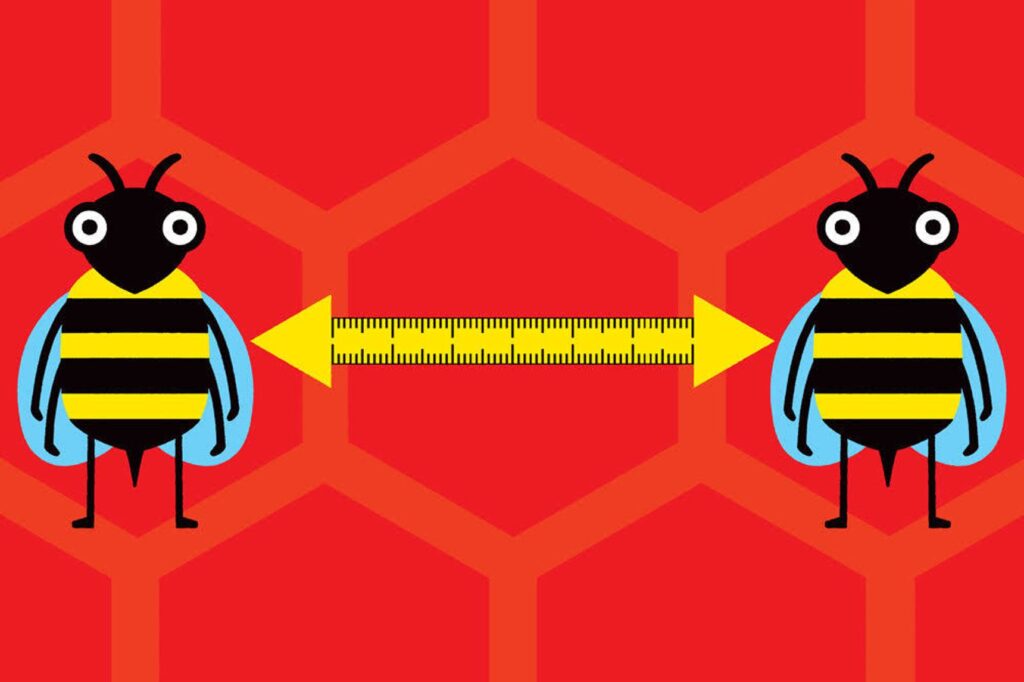How to Bee Socially Distanced
By Susan Pinker
www.wsj.com/articles/how-to-bee-socially-distanced-11640285013
Ants do it, bees do it, even baboons in the trees do it. Let’s do it, let’s keep our distance. It’s not so easy for humans, it seems, even when a contagious disease is rapidly spreading. But for honey bees? No problem. A study published last month in the journal Science Advances shows that honeybees start social distancing as soon as a bee brings a dangerous parasite into the hive.
Worthy of its name, the varroa destructor mite carries a virus that can destroy the colony from within. But the presence of the parasite is noticed by the colony’s healthy bees, who change their behavior to limit viral transmission, according to a suite of experiments led by Michelina Pusceddu and Alberto Satta, agricultural researchers at the University of Sassari, Italy, along with colleagues at three other European universities. “Varroa destructor is among the most serious threats to honey bees world-wide and has played a fundamental role in the decline of honey bee colonies all over the Northern Hemisphere in the past decades,” they write.
It’s a scientific parable for our times: A deadly virus descends on us out of the blue and exploits our social habits to expand its territory and reproduce. We’d be goners, except that evolutionarily speaking, a social species has a couple of ways to fight back. In some social animals, like ants, chimps and gorillas, the infected animal acts first: It might move slowly and look a little mangy, or skulk off to self-isolate. Other members of the group then know to avoid it.
But in the noble honeybee, the pest’s intrusion immediately alters the behavior of the healthy forager bees, who know their colony members by smell and can distinguish between the scent of healthy nest mates and those carrying parasites. The presence of the parasite in the colony prompts them to shift their activities away from the uninfected and more vulnerable members of the hive—the queen, the babies and their nurses.
The study’s authors call this change in the healthy bees’ behavior social distancing, and they expected to see more of it in the infested hives. Their experiment consisted of observing the behavior of bees in six colonies. Half of the hives had been regularly treated with oxalic acid, a natural pesticide, to make sure they were mite-free. A varroa destructor infestation bloomed naturally in the other three hives. The researchers videorecorded what went on in the hives over three consecutive days.
Forager bees are the explorers who leave the hive to find the nectar that nourishes the colony. Upon their return, they communicate where the sweetest flowers are, how big the nectar cache is and whether more foragers are needed. They do this by executing a waggle and vibration dance in the shape of a figure eight.
The comparison among hives revealed a stark difference in the forager bees’ dances, depending on the presence of infection. When the researchers compared the varroa-infested hives with uninfested ones, they found that the number of foraging dances was the same in the two groups, but the location of the dance floor differed. In the infected hives, the foragers were more likely to stay on the perimeter of the hive. In the uninfected hives, the foragers danced and waggled to their hearts’ content in the inner sanctum.
“The frequency of dances on the outermost frames is about 70% in infested colonies, compared with 10% in the uninfested colonies. So I would say that the probability of foragers being at the outer limits of the hive in infested colonies is seven times as likely as in uninfested colonies,” wrote Dr. Satta in an email.
Even one-day-old bees changed their behavior when detecting infection around them. They groomed each other more—which removed the mites—and fed and rubbed their antennae against nest-mates less. In other words, the presence of disease changed their social habits. If one-day-old honeybees can do it, so can we.


